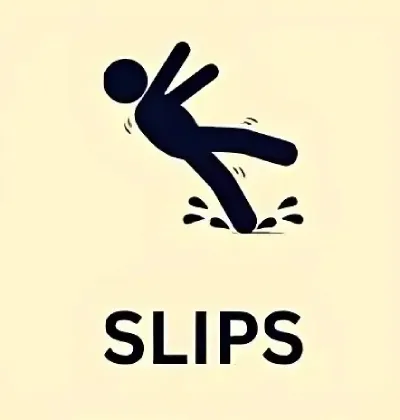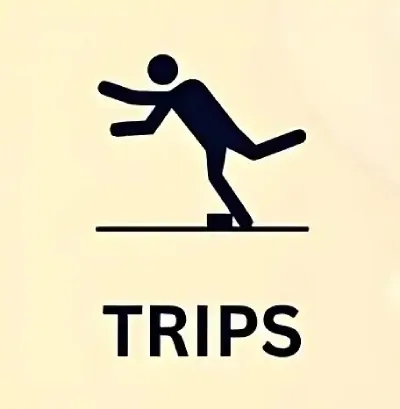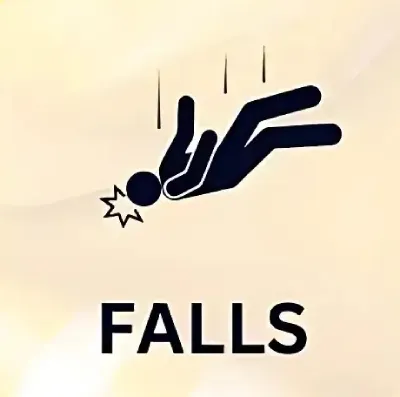Causes of Slips, Trips, and Falls
Slips, trips, and falls might sound simple—but they remain the biggest cause of workplace injuries in the UK. According to the Health and Safety Executive (HSE), they account for over 30% of all reported non-fatal injuries at work. For security officers, who are constantly moving across sites, patrolling varied environments, and acting as the public face of safety, these risks are part of daily life.
Understanding the causes is the first step in preventing them.



Common Causes You’ll Face on Site
1. Wet or Contaminated Floors
Rainwater dragged in at entrances, spills in food courts, or cleaning products left without warning signs.
Example: A receptionist slips near the entrance because rainwater wasn’t mopped up or signed off.
Tip: Always check entrances on wet days—these are high-risk hotspots.
Key Consideration: Ask yourself: Would a member of the public know this floor is wet before stepping on it?
2. Uneven Surfaces and Poor Flooring
Loose mats, cracked tiles, frayed carpets, or raised thresholds in doorways.
Example: During a night patrol, an officer trips on a curled mat in a side corridor.
Tip: Don’t ignore “small” hazards. A curled mat corner can cause the same injury as a puddle.
Consequence: If ignored, it can lead to hospital treatment and questions about your site’s inspection regime.
3. Poor Housekeeping and Obstructions
Boxes left in corridors, trailing cables from temporary setups, or rubbish not cleared.
Example: A contractor leaves a laptop charger across the control room floor, and an officer stumbles.
Tip: Apply the “Clear Walkway Rule”—if it’s blocking, it’s a hazard.
Pro Tip: Think BSI standards—clear, safe walkways are a requirement in any professional workplace.
4. Inadequate Lighting
Poorly lit stairwells, corridors, or car parks increase risks, especially during night patrols.
Example: An officer misses a step on a dim stairwell during patrol and injures their ankle.
Tip: Carry a torch and always report faulty lighting promptly.
Consequence: Poor lighting is not only a hazard—it may also breach employer duties under the Health and Safety at Work Act 1974.
5. Weather-Related Hazards
Ice, snow, or wet leaves can create serious slip hazards around entrances, car parks, and external patrol routes.
Example: A member of the public falls on untreated ice outside a shopping centre.
Tip: Before your shift, check what measures (like grit or mats) have been put in place.
Key Consideration: NSI and BSI guidance expect professional, planned site maintenance—not “wait and see” approaches.
6. Footwear and PPE (Personal Protective Equipment)
Even a well-maintained site can be unsafe if officers or staff wear the wrong shoes.
Example: A cleaner wearing smooth-soled trainers slips while mopping.
Tip: As an officer, ensure your footwear meets site standards (anti-slip soles) and challenge unsafe PPE practices if spotted.
Consequence: Non-compliance could reflect poorly on both the individual and employer during an HSE inspection.
7. Human Factors – Fatigue, Distraction, and Rushing
Many slips and trips are caused not just by the environment but by human behaviour.
Example: An officer rushing to a radio call doesn’t see a trailing cable and trips.
Tip: Stay situationally aware—slow down, scan your path, and reset your focus after distractions.
Key Consideration: The SIA Standards of Behaviour emphasise professionalism at all times—cutting corners due to tiredness or haste can lead to serious accidents.
Real-World Scenario
It’s a rainy evening at a retail park. You notice water being walked into the tiled lobby with no mats or signs in place. Shoppers are rushing in with umbrellas and bags. Within minutes, a customer slips.
A professional officer:
Reassures the casualty.
Blocks access with barriers or signs.
Calls for cleaning support.
Logs the incident in the accident book.
Reports the hazard for long-term action (e.g. larger mats or canopy installation).
Outcome: Not only is the site made safe, but the officer demonstrates vigilance, quick action, and compliance with HSE expectations.
What Happens If Causes Are Ignored?
Casualty Harm: A “simple” slip can mean a broken wrist, concussion, or months off work. For the victim, it’s life-changing—not just a stumble.
Your Professional Risk: Missed hazards = negligence. That can put your SIA licence, and your future in the industry, on the line.
Employer Risk: Expect HSE investigators, costly fines, and compensation claims—all because a preventable hazard was overlooked.
Reputation Damage: One accident spreads fast. Staff, visitors, and the public quickly lose confidence in both your professionalism and the site’s safety.
Tip: Prevention is invisible success—nobody thanks you for the accident that didn’t happen, but that’s what proves you’re doing your job right.
Professional Priorities on Patrol
Being a security officer isn’t just about watching CCTV or checking doors—it’s about owning the safety of the site every time you’re on shift. That means turning awareness into action and proving your professionalism through the small choices you make.
Be proactive: Don’t wait for an accident to happen. Spot hazards early—wet floors, curled mats, loose cables—and deal with them before anyone gets hurt. Think like the public: “Would I feel safe walking here?”
Act first, record second: If a hazard is live, secure it immediately with barriers, signs, or by standing guard. Once the danger is under control, log it properly so the fix is recorded and tracked.
Think teamwork, not solo: You’re part of a bigger safety network. Cleaning staff, contractors, supervisors—all have a role. Quick, clear communication makes hazard management faster and more effective.
Stay sharp under pressure: Tiredness, distractions, or routine patrols can make you miss the obvious. Reset your focus regularly—pause, scan, and ask yourself: “What could hurt someone here?”
Example: During a late-night patrol, you find an unplugged cable trailing across the control room floor. You could ignore it, but a colleague rushing in later might trip. Instead, you move the cable safely, log the hazard, and raise it with the IT team for a long-term fix. That’s what professionalism looks like.
Tip: “See it, sort it, or support it.” If you can fix it safely, do it. If not, secure the area, report it, and support the team who can. Walking past is never an option.
Prevention Is Professionalism
Slips, trips, and falls don’t “just happen.” They always have a cause—whether it’s a wet floor, poor lighting, clutter, or carelessness. And that means nearly every accident can be prevented with sharp eyes and decisive action.
By spotting hazards before they become incidents, staying alert even at the end of a long shift, and taking immediate steps to secure danger zones, you’re not only protecting the public—you’re protecting colleagues, your employer, and your own professional standing as an SIA-licensed officer.
Remember: your actions are the first and strongest line of defence. A single wet floor sign, a quick radio call, or a clear report can be the difference between a safe shift and a casualty in hospital.
Example: A security officer who ignores a loose handrail might save 30 seconds on patrol—but when a cleaner leans on it and falls, that officer could face investigation for negligence. By contrast, the officer who spots it, reports it, and makes the stairwell safe prevents an accident and earns trust from their team and employer.
Tip: Prevention often goes unnoticed—but that’s a good thing. The incident that never happened is the clearest proof of your vigilance.

